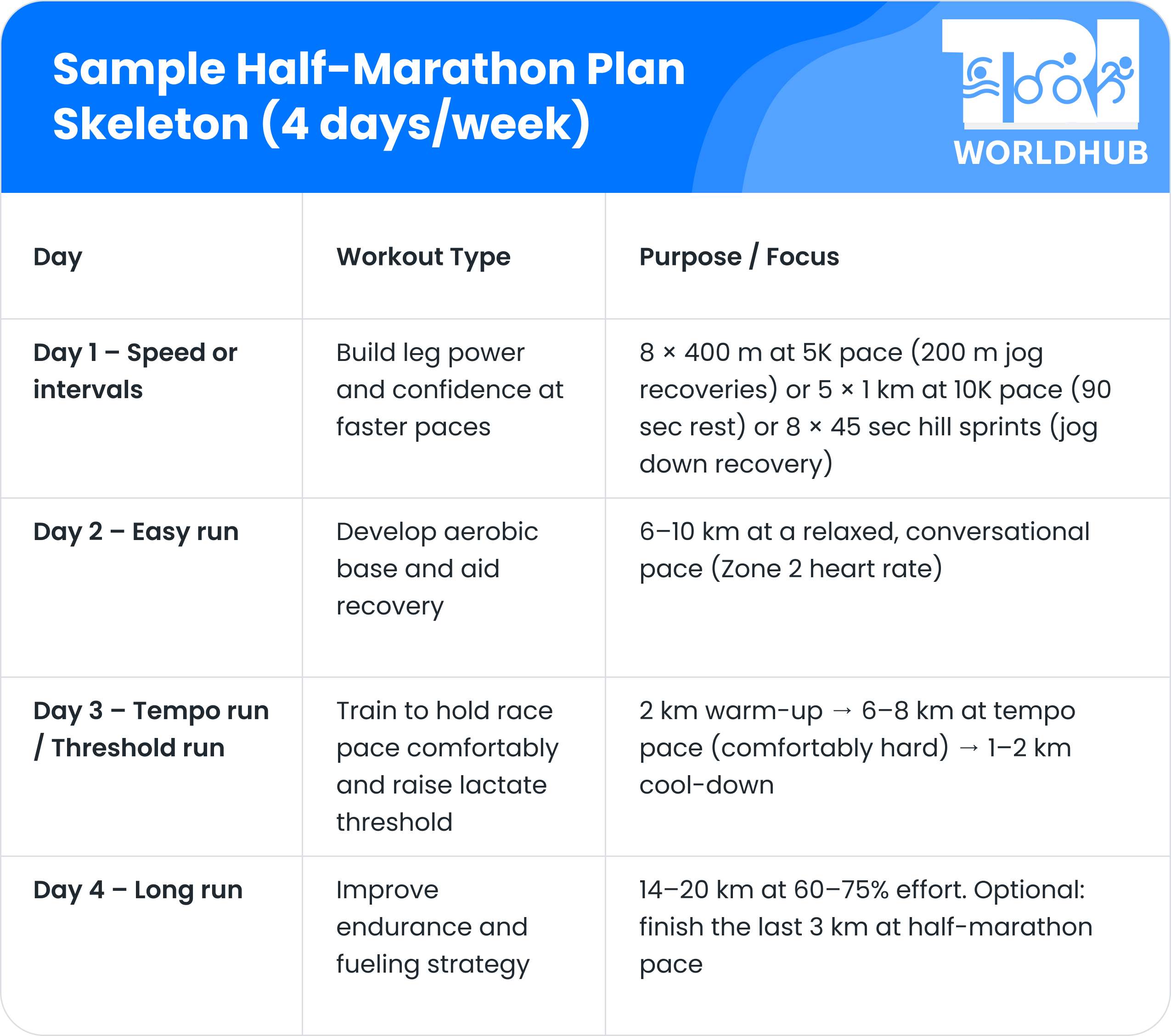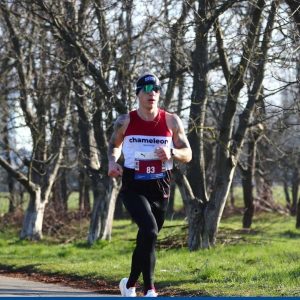Sometimes, your body knows your fitness better than your brain does. This is the story of a race I used as a simple fitness test, a rust-buster after the off-season, that turned into a massive, almost effortless half-marathon Personal Best.
They say you shouldn’t try anything new on race day. Well, I certainly didn’t plan on trying a “4km panic-paced warm-up.” But sometimes, the best performances come from the most chaotic mornings. This is the recap of how I overslept, scrambled to the start, and somehow ran one of the most successful races of my life (so far).
Half-Marathon “Preparation”
Let’s be clear: this was not a target race. My season hadn’t even properly started yet. I had put in consistent training over the winter, building a strong base.
This race took place on April 12, technically before the season had even started. I didn’t plan it as a major event; it was more of a test run to see where I stood after the off-season. I usually have two peaks during the season, and for some reason, the first one always feels stronger than the second. I really need to figure out why. This one definitely confirmed it.
There was no specific preparation for this race. A week before, I just did a short tune-up session, a few 10-minute blocks at high speed, more to wake up the legs than anything else. So my expectations were modest: get a sense of my current pace and fitness, nothing more.
The expectation was to run a 3:45/km pace, with 3:40/km being the most optimistic, dream-scenario goal.
Race Day: Reaching the Half-Marathon Goal Pace
Race morning was… chaotic, to put it mildly. I woke up with a jolt at 6:57 AM. The race started at 7:30 AM. My hotel was 4 kilometers from the start line.
What followed was a blur of adrenaline-fueled panic:
- I threw on my kit.
- I gulped down a caffeinated gel with a splash of water.
- I started my watch and began the most intense “warm-up” of my life.
I arrived at the venue just 8-10 minutes before the race started.
My “jog” to the start line was at a blistering 3:40/km pace. I was starting from the very back of the pack.
The Race Itself: Executing the Half-Marathon Training Plan
Miraculously, from the moment the race started, a sense of calm focus washed over me. The hard part— just getting there — was over. Forced to start further back, my first kilometer was a slow 3:52-3:55, which was significantly below my target half-marathon pace.
The main pack, running at 3:35-3:36, pulled away. At the time, it was frustrating, but in hindsight, it was the best thing that could have happened. It forced me to start slow, to be patient, and to avoid the classic mistake of going out too fast with the elites.
I wasn’t watching my heart rate or overanalyzing the data. In fact, this was the first race where I didn’t look at my watch at all, except when it beeped at each kilometer. I just ran by feel.
I aimed to keep my pace within a ±3-second window, and it felt surprisingly easy. My plan was to stay around 3:40/km, which was the optimistic target, but realistically, I expected 3:45/km.
Instead, my first 10 km averaged around 3:38–3:39/km, and I held that rhythm comfortably. Toward the end, I even managed to speed up a little, and my last 2 km were around 3:35/km, dipping into Zone 5 effort as I later saw from my heart rate data.
Speaking about heart rate, it stayed between 162–165 bpm for most of the race, never spiking out of control. No cramps, no heavy breathing, no pain, just smooth, steady running. When I crossed the line at 1:17:18, it didn’t even feel like a max effort. I finished fresh, and the next day, zero soreness.

How to Create a Personalized Half-Marathon Training Plan
If I wanted to train for another half-marathon PR, that’s how I would have approached mt training program development:
1. Starting with Honest Self-Assessment
Before writing a single workout, you need a clear snapshot of your current running identity. Ask yourself:
- What is my recent running history? Look at your last 4-6 weeks. What has your average weekly mileage been? What’s the longest run you’ve comfortably completed?
- What is my half-marathon goal? Is it just to finish, to break 2 hours, or to set a half-marathon PR? Your goal must be realistic relative to your self-assessment. You can’t run a 1:30 half-marathon if your current easy pace is 6:00/km.
- What is my injury history? Be brutally honest. What niggles tend to pop up when you increase mileage running? This will dictate how aggressively you can ramp up.
- What is my schedule like? How many days per week can you realistically commit to running? A busy parent with a full-time job might have 4 days, while a college student might have 6.
2. Plan from a Peak Week
This is the most powerful personalization technique. Instead of starting from week 1, start from your goal race and work backward to plan your peak training week (typically 3-4 weeks before the race).
Here is how to do it:
- Define your peak week. Based on your goal and self-assessment, what is the maximum, sustainable weekly mileage you can handle? For a first-timer, it might be 40 km. For an advanced runner, it could be 80+ km.
- Work backward to week 1. Plan a gradual, progressive increase in mileage from your current base running training plan to that peak week. The golden rule is the 10% Rule: do not increase your total weekly mileage by more than 10% from the previous week. Every 3rd or 4th week, plan a “down” week with reduced mileage to allow for recovery and adaptation. For example, if your peak week is 50 km, and your current base is 25 km, you need about 8 weeks to build up safely (25 > 27.5 > 30 > 25(down) > 33 > 36 > 40 > 45 > 50).
3. Structure Your Training Week
Every run in your week should have a specific purpose. A cookie-cutter plan just has you “run 5 miles.” A personalized plan assigns intent. Here’s a sample framework for a 4-day running week:
- Day 1: Base run. The bread and butter. A comfortable, conversational pace to build aerobic endurance and mileage. (This is 80% of your training).
- Day 2: Speed or strength work. This is where you build fitness. Don’t just do random intervals. Choose a workout that aligns with your goal:
- For a PR (like a 1:17): Lactate Threshold intervals (e.g., 4 x 8 minutes at a “comfortably hard” pace with 2-minute jog rests) are crucial. They teach your body to clear lactate and sustain a faster pace. That’s the same principle behind the Norwegian training method, a science-based approach that takes threshold workouts to a whole new level.
- For a new runner: Strides or short hill repeats to build running economy and power.
- Day 3: Recovery run. Very slow and short. The goal of a recovery run is to promote blood flow and aid recovery without adding fatigue. Leave your ego at home.
- Day 4: Long run. The cornerstone of endurance. Gradually increase this distance each week. The pace should be slow and comfortable, like 30-60 seconds per kilometer slower than your goal race pace. Use this marathon pace calculator to estimate your half-marathon goal pace.
4. Schedule The Non-Running Parts
To reach your goal half-marathon race pace, you also need to incorporate other workouts into your training routine. These are:
- Strength training is a non-negotiable for injury prevention. 2x per week, focus on single-leg strength (lunges, single-leg deadlifts), core stability (planks, bird-dogs), and plyometrics. Don’t exhaust yourself before a key run.
- Mobility & Flexibility routine, such as 10 minutes of dynamic stretching before runs and static stretching after, can work wonders. Check out these must-do mobility exercises for runners to introduce them into your routine.
- Sleep & Nutrition is where you actually get faster. Your body adapts and repairs during sleep. Fuel with quality carbohydrates and protein, especially after hard efforts. Practice your race-day nutrition strategy on your long runs.
5. Build in Flexibility and a “Plan B”
Life happens. A personalized plan has built-in escape hatches.
- The 80/20 rule is one of the key strategies for runners and triathletes. Aim to complete 80% of your plan. If you miss a workout, don’t panic and don’t try to “make it up.” As we’ve explored in this article on 80/20 triathlon training, this is the fastest way to injury and burnout.
- Listen to your body and learn the difference between “I’m tired” (normal training fatigue) and “I’m hurt” (sharp, persistent pain). If it’s the latter, take an extra rest day or do a cross-training workout.
- Have a “Plan B” workout, in case you’re short on time. Always have a go-to shorter, but still high-quality workout. If you’re feeling flat, know when to swap a hard interval day for an easy run.
Sample Half-Marathon Plan Skeleton (4 days/week)

Key Takeaways for Your Next Half-Marathon PR Attempt
These are just some tips on reaching your goal half-marathon pace, based on personal experience and years of training:
- Schedule a “fitness test” race. Don’t make every race a high-stakes goal. A low-pressure event early in the season can reveal your true fitness and build confidence.
- Embrace a slow start. Being forced to hold back at the beginning is a strategic gift, not a setback. It conserves vital energy to cross that finish line faster.
- Run by feel (Sometimes). Try a race or a key workout without staring at your watch. Your body’s perceived effort is often smarter than any pace plan, especially when you’re in great shape.
- Trust your base fitness. Consistent base work is what creates these breakthrough performances.
This race was a powerful reminder that running isn’t always perfect. Sometimes, the wildest days produce the best results.






